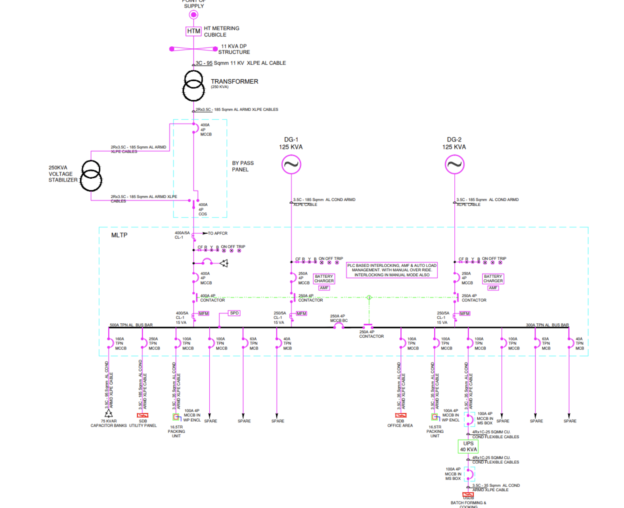- 1. What is a Load Flow and short-circuit study?
A Load Flow study is an iterative method for analysing system voltage, current, and power in a power distribution network under stable and fault conditions.
Gauss-Seidel, Newton-Raphson, and Fast Decoupled methods are commonly adopted iterative methods to study load flow.
2. Why is a Load Flow & Short-circuit Study essential?
Today’s mission-critical businesses are highly automated, designed to be dynamic in response to variations in business needs, with stability and reliability as essential requirements. UPTIME INSTITUTE has identified the major causes of Data Centre failures, most of which are attributable to power interruptions, followed by server crashes and other factors. This situation has necessitated the establishment of a steady and reliable power distribution system that is designed to meet business needs in the most optimised manner. Load Flow and Short Circuit studies are among the most important analyses for power distribution networks.
These studies can provide a range of critical requirements for operations.
Enhance the stability and reliability of the power distribution network.
Prevent nuisance tripping, isolate faulty sections during faults, and minimise the impact on healthy network components.
Recalibrate and reset protection relays to function within their design specifications.
Conduct a feasibility study and plan to implement significant changes in power sourcing and load connections.
Perform an iterative study of interconnected power networks with incremental changes and transient simulations Procedures.
3. Input data requirements
Accurate data entry is crucial for load flow and short-circuit scenario analysis. It includes General information, System data, Bus data, Load types, Power distribution network data, and Power sourcing data such as generating equipment, transformers, and renewable sources.
A single-line Diagram indicating the equipment nameplate data of Transformers, Diesel Engine Generators, UPS, Power Distribution Boards, Capacitor Banks, and connected loads.
System Voltage, MVA and X/R ratio
Impedance in or % Per Unit of Power Transformers, all Feeders
Maximum Load Current and Prospective Loading
Current and Potential Transformers (CT and PTs) and Performance Curves
Existing Protection Devices, Settings and Time Current Characteristics
Reactive Power (KVAR) Control, Voltage Control, and the Scheduled Power Factor (pf) of the system.
4. Data Collection
Single Line Diagram
Nameplate details of Transformers, Diesel Engine Generators
Power cable runs, types, size and length
Details of the Switchgear Panel, UPS, Power Distribution Boards
Protection relays settings
Manufacturers’ (TCC) data Time Current Characteristics curve of protection devices
Current Load Data
Branch network data
5. Software Tools
Software encompasses programs designed to implement, evaluate, and execute short-circuit protection system coordination, load flow analysis, harmonic analysis, system stability, motor starting, and grounding.
Software tools for analysing nonlinear power flow conditions are applied online and offline.
Online software (ETAP, DigSILENT, PSCAD) assesses and manages real-time load flow and can be integrated with BMS or the plant SCADA system to control and regulate KVAR, active harmonic compensation, and bus voltage to optimise power flow management.
The software program can be used to control the switching ON and OFF of power sources, connected load, and safety features designed for interconnecting various sources and load centers.
Offline software (ETAP, PSS®SINCAL, EA-PSM) is commonly adopted to investigate and establish optimal power flow through what-if scenario analysis, forming the basis for future power sourcing integration, load management, capacitor bank installation, renewable energy integration, and predictive maintenance planning of power distribution systems. Examine the stability of voltages at all buses within the specified limits.
6. Analysis Observations
Grid power capacity and availability
Adequacy and resiliency of grid and backup power bus capacity, power cable ampacity, circuit breakers, isolators, online switches, and UPS capacity
Power interruption scenario analysis
Short circuit analysis
Protection system coordination
7. Load flow and short circuit analysis ensure power network reliability, guiding the planning of cables, switchgear, and protection elements.
8. Reference Standards
IEEE 3002.2-2018
IEEE 242-2001
IEC 255-3
IEC 61642

LOAD FLOW AND SHORT CIRCUIT STUDY FOR A MISSION CRITICAL FACILITY
Leave a reply
